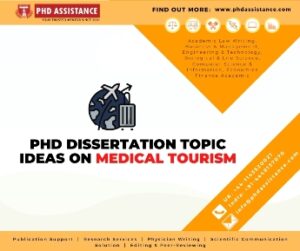PhD Dissertation Topic Ideas on Medical Tourism
In Brief
Medical Tourism is the process of travelling outside to receive medical treatment. Initially, the term applied to patients travelling from less-developed areas to developed countries in need of services that were not available in their home countries (1).

Medical tourism and its importance:
Today, we’re seeing Qualitative and Quantitative changes in patient migration as patients move from more developed to less developed countries searching for health care. The comparatively low cost of treatments in less developed countries, the proliferation of low-cost airlines, and improved marketing and online patient awareness about medications’ availability are behind this medical services transition (2).
Introduction
Medical tourism is rising in importance as a business and as a field of study in academia. Hospital tourism is a form of healthcare tourism where patients can access medical facilities outside their home country for treatment or recovery (3). Even though medical tourism and healthcare tourism are often used interchangeably, healthcare tourism is an umbrella word that includes medical tourism and thermal health tourism, spa-wellness tourism, and elderly/disabled tourism. Cardiovascular surgery, radiotherapy, organ transplantation, miscarriage and IVF therapies, aesthetic/plastic surgery, dialysis treatment, and dental and eye care are also examples of Medical Tourism Services (4).
Review of medical tourism topics for PhD Dissertations
| S.No | Dissertation topics | Future scope |
| 1. | The Picture of Medical Tourism Destinations and the Plan to Return: A Review of Chinese Medical Tourists in Malaysia
Huei Cham et al. (2021) |
The medical tourism industry’s increasingly competitive nature has pressured destination marketers to continuously attract new international medical tourists and revisit the future destination. |
| 2. | Impacts of Service Quality, Satisfaction and Trust on the Loyalty of Foreign Patients in Malaysian Medical Tourism
Aljumah et al. (2020) |
This study will be beneficial to the Malaysian medical tourism hospitals’ management to improve their service quality and service delivery by making a customised plan. By having an efficient service delivery directed to the foreign patient tourists, the foreign patients’ loyalty could be improved for the Malaysia hospitals |
| 3. | Data mining network text study of medical tourism in newspapers: the case of South Korea
Kim. S et al. (2019) |
Therefore, future studies should collect and analyse data that reflect medical tourists’ direct experiences from SNS, such as Twitter, blogs, and Facebook. Additionally, because not all newspaper articles on medical tourism were collected, there are limitations concerning the generalisation of this study’s results to perceptions of medical tourism. |
| 4. | Medical Tourists’ Future Destination Choice
Abu Hassan et al. (2018) |
The results of this study will underline that destination marketers must take particular consideration of the image factor as this will affect tourists’ future destination choice. Interestingly, the research will uncover the dimensions of Malaysia’s destination image manifested by underlying factors of tourism destination attractions and medical healthcare attractions. |
Current researches in medical tourism
Medical tourism (MT) is an essential part of many countries’ service economies. As a result, understanding the targeting and recruiting of MT patients is crucial for MT providers. Health tourism (MT) is becoming a more important feature of many countries’ service economies. Health treatment has been successfully packaged and sold in both industrialised and emerging environments. The range of remedies available varies from bariatric care and fertility therapy to several cosmetic and non-essential procedures. Medical tourists seek healthcare abroad for several reasons, including consistency, the pace of access to care, and even tourism activity linked to the medical facility’s location (5).
The majority of study has concentrated on the reasons of people who engage in medical tourism, also known as “medical tourists.” the relative cost of domestic treatment (broadly described as ‘cost savings’); the comparative waiting period for domestic treatment (‘long waiting lists’); healthcare quality; a variety of facilities and choice; Inadequate or non-existent insurance; right to protect confidentiality and privacy; cultural affinity in terms of language, norms, faith, and food; access to the most cutting-edge technology and treatments; therapies inaccessible (‘circumvention tourism’) or unaffordable in their home countries; mistrust and unfamiliarity with the receiving country’s healthcare systems(6)
Further Research of PhD topic on medical tourism
Medical tourism is growing in importance, and tourism companies cannot continue to ignore it.
- The variables that influence medical tourists’ choice (e.g., adequate sample size) of destinations can be studied using quantitative approaches to assess the market for medical tourism.
- Medical tourism supply in a given region or nation may be examined using qualitative approaches. (e.g. highly trained health workers)
- To expose the current situation in a given region or area, a combined analysis encompassing both supply and demand viewpoints and using both qualitative and quantitative methods may be conducted.
- A longitudinal study of a specific medical tourism destination will allow for a more in-depth examination of both supply (e.g. countries provideuniversal healthcare) and demand over time (e.g. shifts within nations).
- A cross-cultural analysis of the medical tourism industry in two or more regions or countries may be conducted (7).
Conclusion:
Even though medical tourism, a growing and profitable tourism industry, has gotten a lot of attention in recent years, particularly in developed countries, only a few academic studies on the topic have been written. The purpose of this thesis is to afford a detailed theoretical context for future studies, given the lack of scholarly literature in this field.
We consider using both Qualitative and Quantitative Methods to validate the model in every medical tourism destination. The findings will aid in revealing the current state of affairs in the goal. They will provide invaluable information to private and public sector players in the medical tourism industry (8).
References
- Tat-Huei Cham, Yet-Mee Lim, Bee-Chuan Sia, Jun-Hwa Cheah & Hiram Ting (2021) Medical Tourism Destination Image and its Relationship to Revisit: A Study of Chinese Medical Tourists in Malaysia, Journal of China Tourism Research, 17:2, 163-191,
- Aljumah, A., M. T. Nuseir, and A. Islam. “Impacts of service quality, satisfaction and trust on the loyalty of foreign patients in Malaysian medical tourism.” International Journal of Innovation, Creativity and Change2 (2020): 451-467.
- Hassan, Norhaslin Abu, and Mohamad Abdullah Hemdi. “Medical Tourists’ Future Destination Choice.” Asian Journal of Behavioural Studies13 (2021): 117-127.
- Kim, Sohyeon, and Won Seok Lee. “Network text analysis of medical tourism in newspapers using text mining: The South Korea case.” Tourism Management Perspectives31 (2020): 332-339.
- Karadayi Usta, Saliha, and Seyda SerdarAsan. “A conceptual model of medical tourism service supply chain.” Journal of Industrial Engineering and Management2 (2020): 246-265.
- J., Praveenkumar, K., & Vinayagamoorthi, G. (2019). Medical tourism in India. International Journal of Recent Technology and Engineering, 8, 695-698.
- Al-Talabani, H., Kilic, H., Ozturen, A., & Qasim, S.O. (2019). Advancing medical tourism in the United Arab Emirates: Toward a sustainable health care system. Sustainability (Switzerland), 11(1).
- Abadi, F.A., Sahebi, I.G., Arab, A., Alavi, A., & Karachi, H. (2018). Application of best-worst method in evaluation of medical tourism development strategy. Decision Science Letters, 7, 77-86.
 Previous Post
Previous Post Next Post
Next Post
